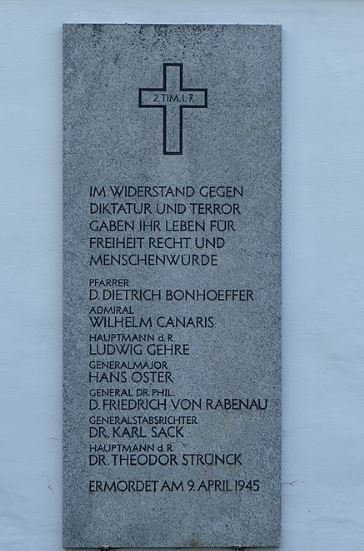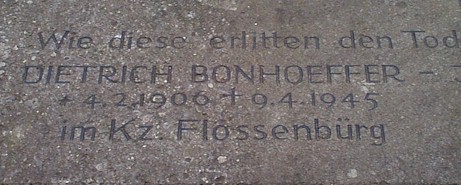World War II Resistance Figure. He received recognition as a German Lutheran pastor who resisted the Nazi Forces of World War II. He published several books on the subject of his faith during the war. Born into a family of eight children, he had a twin sister, and his father was a college professor of psychiatry and neurology. He studied theology at Tubingen University before serving in 1928 in the German parish in Barcelona, Spain. In 1930, he was awarded a Sloane Fellowship, allowing him to attend Union Theological Seminary in New York City, completing his theological examinations. In 1931 he accepted a position as lecturer in Theology at the University of Berlin, and in November, was ordained at St. Matthias Lutheran Church in Berlin. In 1933, alarmed with the changes in the politics in Germany, he wrote an essay, "In The Church and the Jewish Question," in which he pledged to fight political injustice and questioned the Nazi Party's agenda of persecuting the Jewish population. That fall, he accepted the pastorate of the German Evangelical Church in London, England. He and other opponents of Nazi interference in Church affairs formed the "Confessing Church," which advocated open resistance against Nazism. The Nazi Party was attempting to have one German protestant church which would support the Nazi agenda. In 1934, he returned to Germany to teach at Finkenwalde, a Confessing Church seminary. Students, however, were blocked from taking clerical posts by the established church. In August of 1937, the German government declared the training of the Confessing Church was illegal, and Finkenwalde was closed in September, with 27 of Bonhoeffer's students being arrested. He wrote two volumes after the closing of the seminary, "Life Together" and the 1937 "The Cost of Discipleship," which became a classic theological text. In June of 1939, at the invitation of Union Theological Seminary in New York, he returned to the United States. He was encouraged to remain there by friends but decided he had to face the coming trials with his own people, returning to Germany only a month later. Under the scrutiny of the Gestapo, he was banned from Berlin. Nazi authorities forbade him to speak in public and required him to regularly report his activities to the police. He was forbidden to print or publish. Ironically, he managed to secure a position with Abwehr, the Nazi German intelligence-gathering agency, claiming his worldwide ecumenical contacts would be of use to Germany. The ploy succeeded, and the position protected him from conscription to active service. Under Abwehr's protection, he served as a courier for the German resistance, meeting with the Allies through his ecumenical contacts abroad in the hope of gaining their support. He also became involved in operations to help German Jews escape to Switzerland. On April 5, 1943, he was arrested and taken to Tegel Prison in Berlin. He remained there for almost 18 months. Sympathetic guards helped smuggle his letters out of prison, and these uncensored letters were posthumously published in 1951 in the book, "Letters and Papers from Prison." Plans were made for his escape, but ultimately, he decided against the attempt, fearing Nazi retribution on his family, two of whom were in prison with him. In October 1944, Bonhoeffer was moved to the Gestapo prison in Berlin. He was charged with conspiring to rescue Jews, using official travel for other interests, and abusing his intelligence position. There was minor evidence of his involvement in the July 20, 1944, assassination attempt of Nazi leader Adolph Hitler. In February of 1945, he was taken to Buchenwald and was then transferred to the Flossenbürg Concentration Camp, where he was hanged alongside at least six colleagues on April 9, 1945 during the collapse of the Nazi regime. The German Evangelical Church in London, where he had served between 1933 and 1935, was destroyed by Nazi bombings in 1944. When the church was rebuilt in 1958, the church was named Dietrich-Bonhoeffer-Kirche in his honor. He has two cenotaphs: Dorotheenstädtischer Friedhof in Berlin and the Flossenbürg Concentration Camp Memorial. A full-standing statue of him is located outside of St. Peter's Church in Hamburg, Germany. His statue is one of the four on exhibit at the Gallery of 20th Century Martyrs at Westminster Abbey in London. He became engaged to be married shortly before being arrested.
World War II Resistance Figure. He received recognition as a German Lutheran pastor who resisted the Nazi Forces of World War II. He published several books on the subject of his faith during the war. Born into a family of eight children, he had a twin sister, and his father was a college professor of psychiatry and neurology. He studied theology at Tubingen University before serving in 1928 in the German parish in Barcelona, Spain. In 1930, he was awarded a Sloane Fellowship, allowing him to attend Union Theological Seminary in New York City, completing his theological examinations. In 1931 he accepted a position as lecturer in Theology at the University of Berlin, and in November, was ordained at St. Matthias Lutheran Church in Berlin. In 1933, alarmed with the changes in the politics in Germany, he wrote an essay, "In The Church and the Jewish Question," in which he pledged to fight political injustice and questioned the Nazi Party's agenda of persecuting the Jewish population. That fall, he accepted the pastorate of the German Evangelical Church in London, England. He and other opponents of Nazi interference in Church affairs formed the "Confessing Church," which advocated open resistance against Nazism. The Nazi Party was attempting to have one German protestant church which would support the Nazi agenda. In 1934, he returned to Germany to teach at Finkenwalde, a Confessing Church seminary. Students, however, were blocked from taking clerical posts by the established church. In August of 1937, the German government declared the training of the Confessing Church was illegal, and Finkenwalde was closed in September, with 27 of Bonhoeffer's students being arrested. He wrote two volumes after the closing of the seminary, "Life Together" and the 1937 "The Cost of Discipleship," which became a classic theological text. In June of 1939, at the invitation of Union Theological Seminary in New York, he returned to the United States. He was encouraged to remain there by friends but decided he had to face the coming trials with his own people, returning to Germany only a month later. Under the scrutiny of the Gestapo, he was banned from Berlin. Nazi authorities forbade him to speak in public and required him to regularly report his activities to the police. He was forbidden to print or publish. Ironically, he managed to secure a position with Abwehr, the Nazi German intelligence-gathering agency, claiming his worldwide ecumenical contacts would be of use to Germany. The ploy succeeded, and the position protected him from conscription to active service. Under Abwehr's protection, he served as a courier for the German resistance, meeting with the Allies through his ecumenical contacts abroad in the hope of gaining their support. He also became involved in operations to help German Jews escape to Switzerland. On April 5, 1943, he was arrested and taken to Tegel Prison in Berlin. He remained there for almost 18 months. Sympathetic guards helped smuggle his letters out of prison, and these uncensored letters were posthumously published in 1951 in the book, "Letters and Papers from Prison." Plans were made for his escape, but ultimately, he decided against the attempt, fearing Nazi retribution on his family, two of whom were in prison with him. In October 1944, Bonhoeffer was moved to the Gestapo prison in Berlin. He was charged with conspiring to rescue Jews, using official travel for other interests, and abusing his intelligence position. There was minor evidence of his involvement in the July 20, 1944, assassination attempt of Nazi leader Adolph Hitler. In February of 1945, he was taken to Buchenwald and was then transferred to the Flossenbürg Concentration Camp, where he was hanged alongside at least six colleagues on April 9, 1945 during the collapse of the Nazi regime. The German Evangelical Church in London, where he had served between 1933 and 1935, was destroyed by Nazi bombings in 1944. When the church was rebuilt in 1958, the church was named Dietrich-Bonhoeffer-Kirche in his honor. He has two cenotaphs: Dorotheenstädtischer Friedhof in Berlin and the Flossenbürg Concentration Camp Memorial. A full-standing statue of him is located outside of St. Peter's Church in Hamburg, Germany. His statue is one of the four on exhibit at the Gallery of 20th Century Martyrs at Westminster Abbey in London. He became engaged to be married shortly before being arrested.
Bio by: Linda Davis
Family Members
Advertisement
See more Bonhoeffer memorials in:
Records on Ancestry
Sponsored by Ancestry
Advertisement











